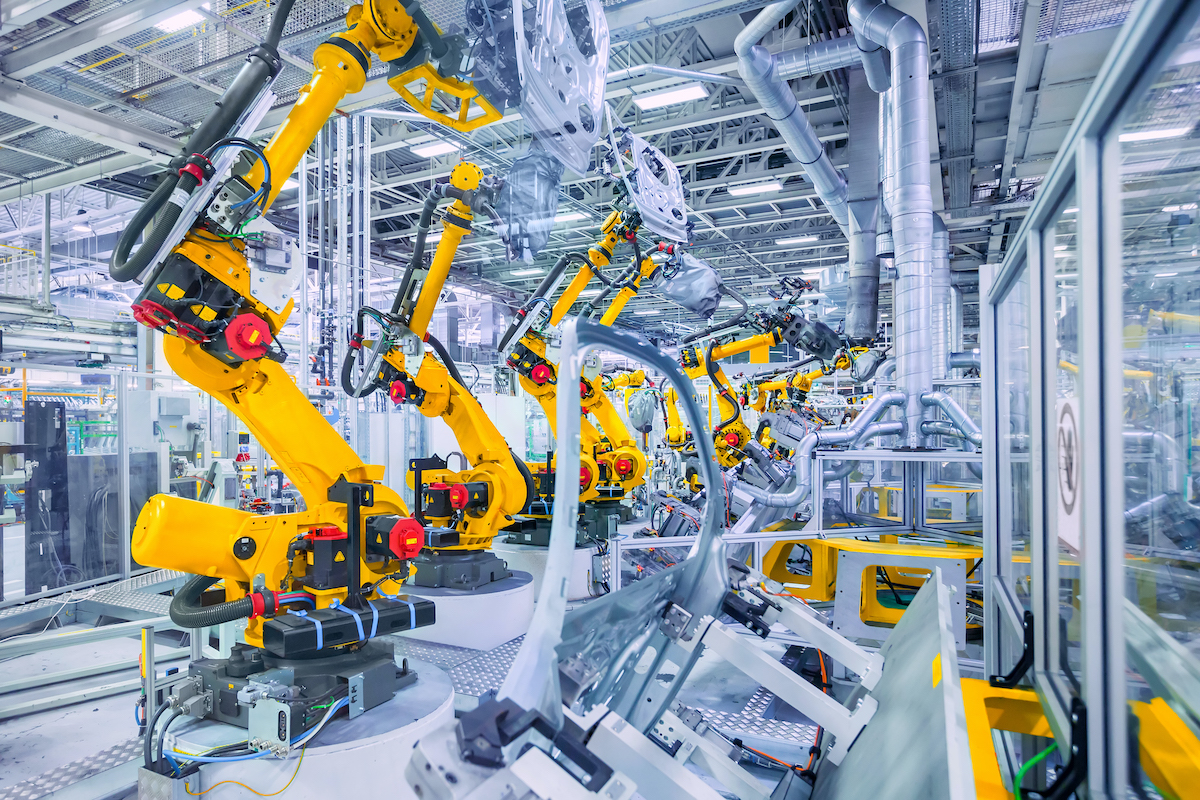Process Monitoring in the Automotive Industry
The Internet of Things (IoT) has become inescapable in reports related to IT. Each individual device on the IoT is identified by an individual Internet address, can access through the Internet and can interact with connected information systems. More and more devices are everyday connected to the Internet. According to the latest Gartner study, this year will conclude with more than 8 billion connected devices globally, representing a 31% increase compared to 2016. In the next years, it is expected that the number of “things” connected to reach 20 billion. These figures will bring total spending on endpoints and services to two trillion dollars in 2017.
On the other hand, not only elements of everyday life will be connected to the internet but also factories, machinery, production facilities or sensor networks, whose term can be described as Industrial Internet of Things (IIoT), commonly used in the United States or Industry4.0 commonly used in Germany.
Automotive Plant and IIoT
IIoT is a concept that aims to promote the optimization of operational efficiency and industrial production, creating greater growth and an improvement in international competitive conditions for companies. The main voices in the sector consider that the trend towards digitization, including the intelligent interconnection of individual machines and even complete production facilities, is a natural evolution of the sector. At the same time, many experts, particularly in the field of the global economy, speak of a new “industrial revolution”.
According to studies carried out by different media, the IIoT market is expected to grow at an annual composite rate of 8% between 2015 and 2020. A key factor influencing this growth factor of the market IIoT is the need to apply monitoring techniques for industrial equipment and processes in order to control their performance and avoid unplanned downtime in the production cycle. There are other factors, such as the need to improve operational efficiency in the production process, improve worker and plant safety, and reduce energy consumption.
Processing, sensing and communications semiconductor device portion of the IoT is set for rapid growth
The processing, sensing and communications semiconductor device portion of the IoT will be as well a rapidly growing segment of the total semiconductor market, The processing semiconductor device segment consists of IoT microcontrollers and embedded processors, while the sensing semiconductor segment includes optical and non-optical sensors.The demand for billions of things will ripple throughout the entire value chain, from software and services to semiconductor devices. These ‘things’ will drive huge demand for individual chips.IoT semiconductor growth will come from industries spanning consumer, industrial, medical, automotive and others.The automotive industry plays a huge role in the semiconductor demand from things through the end of the decade. A need for convenience and more autonomous vehicles are driving tremendous demand for new semiconductor devices silicon in the car. More about Powering the Trillion Sensor Industrial Internet of Things Dream
The importance of process monitoring in the Automotive Industry
Not only big players from the automotive industry, but also small suppliers are challenged every day to provide their customers the best product at the best price. Margins are very tight and a high flexibility is required to guarantee customer’s expectations. To this regard, every single detail in the whole manufacturing chain can play a big role.
Automotive Manufacturing
Manufacturing processes, are per se the first thing which comes into our mind, but also the whole logistic chain, from the reception of the raw material to the delivery of the final product, or the laboratory testing and product development area are part of this puzzle. Even the factory IT systems or the management of the energy supply are crucial so that everything works as it should. Nowadays, in the manufacturing facilities there are lots of elements which differ from the well known sensors, which would need to be monitored as well such as industrial PCs, PLCs, databases, industrial data buses, UPS, or other network elements (routers, switches, etc.).
When we talk about “smart factory” or “smart production”, the manufacturing chain is the most challenged segment. Independently of the specific manufacturing process there are thousands of variables which can influence on the final product quality or the line / machine performance. But, which of those variables are important and which doesn’t? Check out other challenges in designing a fully autonomous system for driverless cars.
It is very important to distinguish which are the most important variables which provides added value to the manufacturing chain and customer, and get them under control. Historically, companies have opted to implement through their manufacturing processes SCADA oriented solutions. Although SCADA is very robust system and well accepted within the industrial community, with the arrival of the IIoT, other Distributed Control Systems (DCS) have taken part of the cake, and it has become less flexible and notably more expensive than the today existing solutions. More about IoT in the Automobile Industry
Advantages of process monitoring in the Automotive Plants
The great advantage about the today’s IIoT oriented systems is the big range of solutions we are offered, and we are just seeing the top of the iceberg. Today’s market offers multiple options, even Open Source software ones which allows to easily gather real-time data and show it in dynamic fully customizable dashboards. This provides a huge advantage to the companies since they are not limited to one single solution from one manufacturer, but they have the whole range available, being possible even to integrate several DAQ systems with one centralized tool.
The advantage of these systems lies also on their flexibilty. Networked systems must remain flexible in order to be able to react to changes quickly. As a result of the openness of the today’s monitoring systems, production systems can be scaled and expanded more easily. Networks can be set up individually and flexibly with a few mouse clicks. Sensor Endpoints can be added to the network or easily displaced from one point to another with few to no impact for the manufacturer, and also no impact to the centralized monitoring platform. Through industrial communication standards, the information will be collected by strategic placed “Coordinators” within the factory, and transmitted to the monitoring platform.
The centralized platform manages the data and the actions to be carried out. It integrates networks beyond hierarchy levels, from the sensor in production through to the smartphone at business level. Production data can be transferred to the ERP system directly or saved in the cloud.
One key point when we talk about automotive industry is Quality. Nowadays everybody talks about quality and sells quality to their customers or to the final consumer. Actually, quality and costs are very interrelated, and therefore car manufacturers struggle to achieve their better results in both aspects. One of the advantages of the monitoring is it contribution to both factors, helping the manufacturer to identify the right spot where to drive an action before something goes wrong, which indirectly impacts in the final cost of the product (less quality incidents helps to a better line or machine performance – OEE – therefore better cost rates). It also helps in quality audits and traceability topics, being the manufacturer able to get all the machine / process important historical data with just few mouse clicks.
Challenges of process monitoring in the Automotive Plants
Maintenance is also one of the most challenging fields and with lot of improvement potential that we can have within the automotive industry. Maintenance costs are very high and it is very important to try to minimize them, and also to avoid machine crashes which impacts the whole manufacturing chain. The emerging market for Predictive Maintenance shows increasing growth as maintenance strategies move from what has been known as Condition-based Maintenance to Analytics- and IoT-enabled Predictive Maintenance. The transition toward Predictive Maintenance is mostly driven by new IoT monitoring platforms, low-cost secure cloud storage as well as analytics vendors that offer dynamic data models play. Predictive maintenance, a 1,5M$ market in 2016 is expected to grow to 11M$ by 2022.
Likewise, automotive security plays a big role within this equation. As a result of ever-more networked systems and the integration of different devices, it is necessary to make production IT more transparent to the outside. This consequently also lead to more security loopholes and points of attack being opened. Integrated security technologies and concepts such as Security by Design can support you to build-up secure production operations.
Conclusion
It is not about the quantity but the quality of the data, the way we treat it and the way we use it. In the era of the IoT and IIoT we need to be able to distinguish from what is needed and what provides us added value to what is “nice to have”. If we are able to be conscious of that, monitoring becomes a very powerful tool.
Currently most of the factories are not IIoT oriented and there still is a long way to go. Anyway, the technological change and economical influences are pushing hard to reach the target, and there is a very interesting and promising future in front of us.
 The article was written by Oscar González Rodríguez, Electrical & Automation Engineer, CMO at Muutech, a monitoring solution’s oriented start-up, focused into information systems, as well as into industrial and production environments.
The article was written by Oscar González Rodríguez, Electrical & Automation Engineer, CMO at Muutech, a monitoring solution’s oriented start-up, focused into information systems, as well as into industrial and production environments.



